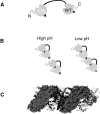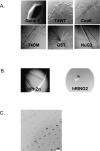Polymer-driven crystallization
- PMID: 17962407
- PMCID: PMC2211692
- DOI: 10.1110/ps.073074207
Polymer-driven crystallization
Abstract
Obtaining well-diffracting crystals of macromolecules remains a significant barrier to structure determination. Here we propose and test a new approach to crystallization, in which the crystallization target is fused to a polymerizing protein module, so that polymer formation drives crystallization of the target. We test the approach using a polymerization module called 2TEL, which consists of two tandem sterile alpha motif (SAM) domains from the protein translocation Ets leukemia (TEL). The 2TEL module is engineered to polymerize as the pH is lowered, which allows the subtle modulation of polymerization needed for crystal formation. We show that the 2TEL module can drive the crystallization of 11 soluble proteins, including three that resisted prior crystallization attempts. In addition, the 2TEL module crystallizes in the presence of various detergents, suggesting that it might facilitate membrane protein crystallization. The crystal structures of two fusion proteins show that the TELSAM polymer is responsible for the majority of contacts in the crystal lattice. The results suggest that biological polymers could be designed as crystallization modules.
Figures




Similar articles
-
Crystals of TELSAM-target protein fusions that exhibit minimal crystal contacts and lack direct inter-TELSAM contacts.Open Biol. 2022 Mar;12(3):210271. doi: 10.1098/rsob.210271. Epub 2022 Mar 2. Open Biol. 2022. PMID: 35232248 Free PMC article.
-
Polymerization of the SAM domain of TEL in leukemogenesis and transcriptional repression.EMBO J. 2001 Aug 1;20(15):4173-82. doi: 10.1093/emboj/20.15.4173. EMBO J. 2001. PMID: 11483520 Free PMC article.
-
DNA binding by the ETS protein TEL (ETV6) is regulated by autoinhibition and self-association.J Biol Chem. 2010 Jun 11;285(24):18496-504. doi: 10.1074/jbc.M109.096958. Epub 2010 Apr 16. J Biol Chem. 2010. PMID: 20400516 Free PMC article.
-
A guide to membrane protein X-ray crystallography.FEBS J. 2021 Oct;288(20):5788-5804. doi: 10.1111/febs.15676. Epub 2020 Dec 31. FEBS J. 2021. PMID: 33340246 Review.
-
Crystallization chaperone strategies for membrane proteins.Methods. 2011 Dec;55(4):293-302. doi: 10.1016/j.ymeth.2011.08.004. Epub 2011 Aug 11. Methods. 2011. PMID: 21854852 Free PMC article. Review.
Cited by
-
Design of an expression system to enhance MBP-mediated crystallization.Sci Rep. 2017 Jan 23;7:40991. doi: 10.1038/srep40991. Sci Rep. 2017. PMID: 28112203 Free PMC article.
-
High resolution structures of the SARS-CoV-2 N7-methyltransferase inform therapeutic development.Res Sq [Preprint]. 2022 Mar 8:rs.3.rs-1370473. doi: 10.21203/rs.3.rs-1370473/v1. Res Sq. 2022. Update in: Nat Struct Mol Biol. 2022 Sep;29(9):850-853. doi: 10.1038/s41594-022-00828-1. PMID: 35291302 Free PMC article. Updated. Preprint.
-
Characterization of the SAM domain of the PKD-related protein ANKS6 and its interaction with ANKS3.BMC Struct Biol. 2014 Jul 7;14:17. doi: 10.1186/1472-6807-14-17. BMC Struct Biol. 2014. PMID: 24998259 Free PMC article.
-
Fusion crystallization reveals the behavior of both the 1TEL crystallization chaperone and the TNK1 UBA domain.bioRxiv [Preprint]. 2023 Jun 14:2023.06.14.544429. doi: 10.1101/2023.06.14.544429. bioRxiv. 2023. Update in: Structure. 2023 Dec 7;31(12):1589-1603.e6. doi: 10.1016/j.str.2023.09.001. PMID: 37398013 Free PMC article. Updated. Preprint.
-
Fusion-protein-assisted protein crystallization.Acta Crystallogr F Struct Biol Commun. 2015 Jul;71(Pt 7):861-9. doi: 10.1107/S2053230X15011061. Epub 2015 Jun 27. Acta Crystallogr F Struct Biol Commun. 2015. PMID: 26144231 Free PMC article.
References
-
- Byrne B., Abramson, J., Jansson, M., Holmgren, E., and Iwata, S. 2000. Fusion protein approach to improve the crystal quality of cytochrome bo (3) ubiquinol oxidase from Escherichia coli . Biochim. Biophys. Acta 1459: 449–455. - PubMed
-
- Chakrabarti S.R. and Nucifora, G. 1999. The leukemia-associated gene TEL encodes a transcription repressor which associates with SMRT and mSin3A. Biochem. Biophys. Res. Commun. 264: 871–877. - PubMed
-
- Chen L., Oughtred, R., Berman, H.M., and Westbrook, J. 2004. TargetDB: A target registration database for structural genomics projects. Bioinformatics 20: 2860–2862. - PubMed
-
- Cohen C. and Tooney, N.M. 1974. Crystallisation of a modified fibrinogen. Nature 251: 659–660. - PubMed
-
- Czepas J., Devedjiev, Y., Krowarsch, D., Derewenda, U., Otlewski, J., and Derewenda, Z.S. 2004. The impact of Lys → Arg surface mutations on the crystallization of the globular domain of RhoGDI. Acta Crystallogr. D Biol. Crystallogr. 60: 275–280. - PubMed
Publication types
MeSH terms
Substances
Grants and funding
LinkOut - more resources
Full Text Sources
Other Literature Sources

